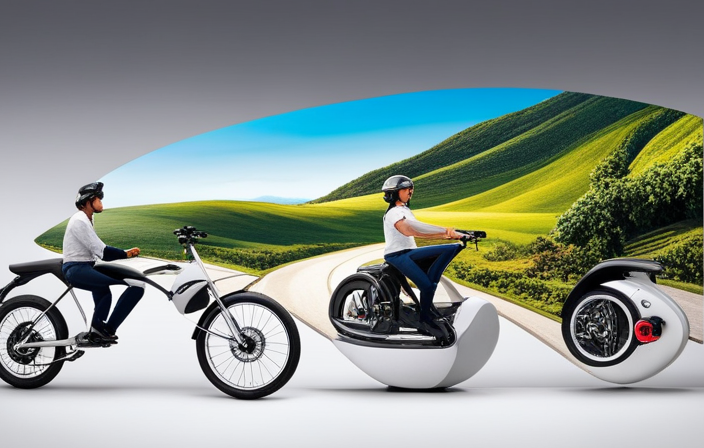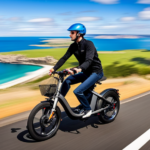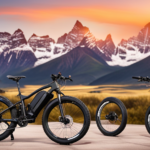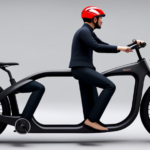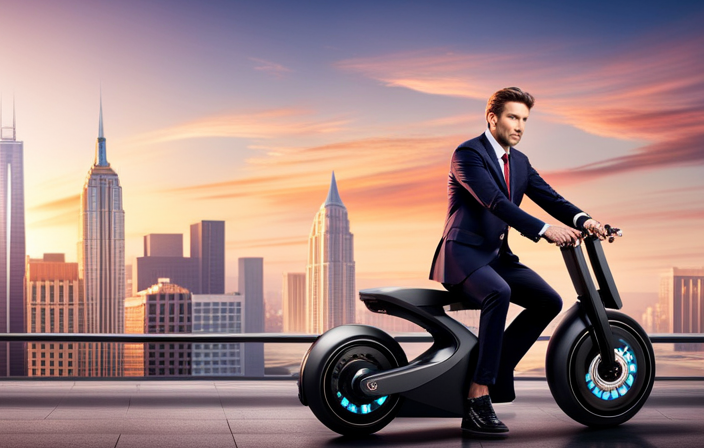I’ve always been fascinated by electric bikes. They offer a convenient, eco-friendly way to get around town while still enjoying the thrill of cycling.
In this article, I’ll guide you through the process of using an electric bike, from understanding the basics to troubleshooting common issues.
We’ll cover everything from choosing the right bike for you to starting and stopping safely.
By the end, you’ll be ready to hit the road and experience the numerous benefits of electric biking.
Key Takeaways
- Familiarize yourself with the controls and practice using throttle, brakes, and gears.
- Understand the display panel and pedal assist levels.
- Start and stop safely, maintaining control and awareness of surroundings.
- Maintain proper body position, keep hands on handlebars, and distribute weight evenly.
Understanding the Basics of an Electric Bike
Understanding the basics of an electric bike is essential before you start riding one. Electric bike maintenance is important to ensure a smooth and safe ride. Regularly check the tires for proper inflation and wear, as well as the brakes for proper functioning. Keep the chain lubricated and clean to prevent rust and ensure smooth pedaling. Additionally, check the battery regularly to ensure it is charged and in good condition.
One of the advantages of electric biking is that it allows you to travel longer distances without getting tired. The electric motor provides assistance when you pedal, making it easier to climb hills and ride for longer periods of time. This can be especially beneficial for commuting or touring purposes.
Another advantage is that electric bikes are environmentally friendly. They produce zero emissions, making them a sustainable mode of transportation. By opting for an electric bike instead of a car, you can reduce your carbon footprint and contribute to a cleaner and greener environment.
Transitioning into the next section about choosing the right electric bike for you, it’s important to consider your specific needs and preferences.
Choosing the Right Electric Bike for You
When it comes to picking the right e-bike for you, it’s important to consider factors like your riding style and terrain. Finding the best electric bike brands and comparing different electric bike models can help you make an informed decision.
Here are four key factors to consider when choosing the right electric bike for you:
-
Riding Style: Determine how you plan to use your e-bike. Are you looking for a bike for daily commuting, off-road adventures, or leisurely rides? Different bikes are designed for different purposes, so choose one that matches your intended use.
-
Terrain: Consider the type of terrain you will be riding on. If you often encounter steep hills or rough trails, look for an e-bike with a powerful motor and sturdy construction. For smoother surfaces, a lighter and more agile bike may be suitable.
-
Battery Range: Electric bikes rely on batteries to provide assistance. Check the battery range of different models to ensure it meets your needs. Longer battery range is ideal for longer rides or if you plan to use your e-bike for commuting.
-
Features and Accessories: Look for additional features and accessories that can enhance your riding experience. This may include suspension systems for improved comfort, integrated lights for safety, or racks for carrying cargo.
By considering these factors and comparing different electric bike models, you can find the perfect e-bike that suits your needs. Once you have chosen the right electric bike for you, it’s time to move on to setting it up.
Transition: Now that you have chosen the perfect electric bike, let’s move on to setting it up for your first ride.
Setting Up Your Electric Bike
Once you’ve chosen the perfect e-bike, it’s time to start setting it up for your first ride. Learning the assembly process is essential to ensure your safety and the bike’s optimal performance.
Begin by unpacking the bike and carefully following the instructions provided. Typically, you’ll need to attach the handlebars and pedals, tighten any loose bolts, and check that all components are securely in place. It’s important to note that the specific assembly process may vary depending on the brand and model of your e-bike, so refer to the manual for detailed guidance.
After assembling the bike, the next step is to adjust the seat height. This is crucial for a comfortable and efficient riding experience. Start by loosening the seat clamp and raising or lowering the seat post to your desired height. Once you’ve found the right position, tighten the clamp securely to prevent any movement while riding.
With the assembly complete and the seat adjusted, it’s time to get familiar with the controls of your e-bike. Understanding how to operate the throttle, brakes, and gears is vital for your safety and enjoyment. Take the time to read the manual and practice using each control before heading out on your first ride. By familiarizing yourself with the controls, you’ll be prepared to navigate and maneuver your e-bike confidently.
Now that your e-bike is set up and you’re comfortable with the controls, it’s time to embark on your first ride and experience the thrill of electric biking.
Getting Familiar with the Controls
Understanding the display panel and learning how to use the pedal assist levels are essential for mastering your electric bike.
The display panel provides important information such as speed, battery life, and distance traveled, allowing you to keep track of your ride.
Understanding the Display Panel
The display panel shows important information about your electric bike’s speed, battery life, and power mode. Understanding the different settings on the display panel is key to maximizing your electric bike riding experience.
The display panel typically has buttons or a touch screen interface that allows you to navigate through the various settings. You can adjust the power mode, which determines the level of assistance the motor provides while pedaling.
Troubleshooting common display panel issues is also important. If the display panel is not turning on or is showing incorrect information, check the battery connection and ensure that it is securely attached. Additionally, make sure that the display panel is properly calibrated and updated with the latest firmware.
Now that we understand the display panel, let’s move on to learning how to use the pedal assist levels.
Learning How to Use the Pedal Assist Levels
Learning how to adjust the pedal assist levels on your e-bike can enhance your riding experience. By optimizing the pedal assist levels, you can customize the bike’s power output to match your preferences and the terrain you’re riding on.
Here are some tips to troubleshoot and make the most of your pedal assist:
- Start by familiarizing yourself with the different levels of assistance available on your e-bike.
- Experiment with different levels to find the one that suits your riding style and desired effort level.
- Consider adjusting the pedal assist level based on the terrain and conditions you’re encountering.
- If you’re having trouble with the pedal assist, check the display panel for any error codes or indicators.
- Consult the user manual or contact the manufacturer for specific troubleshooting steps.
By mastering the pedal assist levels, you’ll have a smoother and more enjoyable ride.
Now let’s move on to the next topic of starting and stopping safely, ensuring a seamless ride from beginning to end.
Starting and Stopping Safely
To safely start and stop an electric bike, it’s important to always keep a firm grip on the handlebars. This ensures that you have full control of the bike and can react quickly to any unexpected situations. Before starting, make sure you are in the correct starting position. Place one foot flat on the ground, with the other foot on the pedal in a raised position. This will give you stability and control as you start moving.
Safety measures should also be taken into consideration when starting and stopping. Always check your surroundings before beginning your ride. Look for any potential obstacles or hazards that may interfere with your path. It’s also crucial to signal your intention to start or stop to other road users. This can be done by using hand signals or verbal cues to indicate your actions.
Here is a table that summarizes the important steps to start and stop an electric bike safely:
| Starting | Stopping |
|---|---|
| Keep a firm grip on the handlebars | Keep a firm grip on the handlebars |
| Ensure correct starting position | Check surroundings for obstacles |
| Signal your intention to start moving | Signal your intention to stop |
| Look for potential hazards | Slow down gradually |
| Place one foot flat on the ground | |
| Use brakes to come to a complete stop |
Now that you know how to start and stop safely, let’s move on to riding techniques and safety tips to enhance your electric bike experience.
Riding Techniques and Safety Tips
Now that you know how to start and stop safely, let’s delve into some riding techniques and safety tips to enhance your electric bike experience.
When it comes to riding techniques, it’s important to maintain a proper body position. Keep your hands on the handlebars, elbows slightly bent, and your weight evenly distributed over the bike. This will help you stay balanced and in control. Additionally, always keep your eyes on the road ahead, scanning for any potential hazards or obstacles.
Maintaining a safe distance from other vehicles and using hand signals when turning or changing lanes is also crucial.
In terms of safety precautions, wearing a helmet is a must. It protects your head in case of an accident and can prevent serious injuries. It’s also important to be visible to others, especially when riding at night. Equip your electric bike with lights and reflectors to increase your visibility. Another important safety tip is to follow traffic rules and regulations. Obey speed limits, stop at red lights, and yield to pedestrians. Lastly, always be aware of your surroundings and stay focused while riding.
Understanding the pedal assist modes allows you to maximize the efficiency of your electric bike. By adjusting the pedal assist level, you can control the amount of assistance the motor provides. This can help conserve battery power and extend your riding range.
Understanding the Pedal Assist Modes
Adjusting the pedal assist level allows you to customize the amount of assistance the motor gives you while riding. It’s an important feature that can greatly enhance your electric bike experience.
Here are some key points to keep in mind when learning to use the pedal assist modes:
-
Start with a low assist level: If you’re new to electric bikes, it’s best to begin with a low assist level. This will give you a feel for the motor’s assistance without overwhelming you.
-
Gradually increase the assist level: As you become more comfortable with the bike, you can start increasing the assist level. This will provide you with more power and speed, allowing you to tackle hills and ride longer distances with ease.
-
Experiment with different levels: Don’t be afraid to try out different assist levels to find the one that suits your riding style and needs. Some riders prefer a higher level of assistance, while others may prefer a more moderate level for a workout.
Understanding and mastering the different pedal assist modes is an essential part of learning techniques for using an electric bike. By adjusting the assist level to your preference, you can optimize your riding experience and make the most of your electric bike’s capabilities.
As you become more familiar with adjusting the pedal assist level, you can also start thinking about managing battery life.
Managing Battery Life
As you become more familiar with managing the battery life, you’ll be able to extend your rides and maximize the usage of your electric bike. Maximizing the range of your electric bike is essential for long-distance rides and ensuring that you don’t run out of battery power midway.
To maximize your range and preserve battery life, there are a few key strategies you can employ.
Firstly, it’s important to start with a fully charged battery. This will provide you with the maximum range right from the get-go. Additionally, paying attention to your riding style can make a big difference. Smooth acceleration and avoiding sudden bursts of speed or braking can help conserve battery power.
Another method to maximize range is to adjust your pedal assist level. Using a lower assist level or even turning it off completely when riding on flat terrain or downhill can help preserve battery life. Save the higher assist levels for when you really need them, such as when navigating hills and inclines.
By implementing these strategies, you’ll be able to extend your rides and make the most of your electric bike’s battery life.
Now, let’s explore how to navigate hills and inclines with your electric bike.
Navigating Hills and Inclines
When tackling hills and inclines, it’s important to choose the appropriate pedal assist level to conserve battery power. This is crucial in maximizing battery efficiency and ensuring a smooth ride.
Here are some hill climbing techniques that I find helpful:
- Maintain a steady cadence: Keeping a consistent pedaling rhythm helps you maintain control and momentum while climbing.
- Shift to a lower gear: Switching to a lower gear allows you to pedal at a higher cadence with less effort, making it easier to conquer steep inclines.
To further enhance battery efficiency, consider the following tips:
- Use the right pedal assist level: Experiment with different levels of pedal assist to find the balance between conserving battery power and getting the assistance you need.
- Plan your route: Avoid unnecessarily steep hills if possible, as they can drain battery life faster.
By implementing these hill climbing techniques and maximizing battery efficiency, you can enjoy a more enjoyable and efficient ride on your electric bike.
Now, let’s transition into the next section about riding in different weather conditions.
Riding in Different Weather Conditions
Riding in different weather conditions can be challenging, but with the right preparation, it can also be enjoyable. When it comes to riding in rainy conditions, the most important thing is to ensure you have the right gear. A waterproof jacket and pants, as well as waterproof gloves and shoe covers, will keep you dry and comfortable. It’s also essential to have good quality fenders on your electric bike to prevent water from splashing up onto you and the bike. Additionally, make sure your tires have good tread and are properly inflated to maintain traction on wet surfaces.
As for riding in snowy conditions, it’s crucial to have the right tires. Look for tires specifically designed for winter riding, with deep treads and studs for added grip on icy surfaces. Lowering the tire pressure slightly can also improve traction. When riding in the snow, it’s important to take it slow and be cautious, as braking and turning can be more challenging. If the snow is particularly deep or slippery, consider attaching snow chains to your tires for even better traction.
Riding in different weather conditions can add excitement and variety to your electric bike rides. By preparing adequately and having the right gear and equipment, you can ensure a safe and enjoyable riding experience, no matter the weather.
Now, let’s explore how to maintain and service your electric bike to keep it running smoothly and extend its lifespan.
Maintaining and Servicing Your Electric Bike
When it comes to maintaining and servicing your electric bike, there are three key points to keep in mind.
Firstly, cleaning and lubricating the bike. This helps to keep all the components running smoothly and prolong their lifespan.
Secondly, regular inspections. These allow you to catch any potential issues before they become major problems, ensuring safe and efficient rides.
And finally, tune-ups. These help to fine-tune the bike’s performance and make necessary adjustments for optimal performance.
Cleaning and Lubricating the Bike
To maintain your electric bike, there are a few important steps to follow. First, make sure you regularly clean and lubricate it. This is crucial for the smooth functioning and longevity of your electric bike. Here are some essential cleaning and lubrication techniques to keep in mind:
-
Clean the bike frame: Use a mild detergent and water to thoroughly clean the frame. Be cautious when using water, as high-pressure water can damage the electrical components.
-
Clean the drivetrain: Remove the chain and cassette, and clean them with a degreaser. Gently scrub them with a brush to remove any dirt or grime.
-
Lubricate the chain: Apply a lubricant specifically designed for bike chains. Make sure to evenly coat the entire chain and wipe off any excess lubricant.
-
Check and lubricate the brake system: Inspect the brake pads for wear and tear. Apply lubricant to the brake cables and adjust them if necessary.
Regular Inspections and Tune-ups
After ensuring that my electric bike is clean and well-lubricated, it is crucial to conduct regular inspections and tune-ups. Regular maintenance is key to keeping my bike in optimal condition and ensuring a safe and smooth ride.
I make it a habit to check the tires for any signs of wear or damage, ensuring they are properly inflated. I inspect the brakes to ensure they are functioning properly and adjust them if necessary. Additionally, I examine the chain for any signs of wear and lubricate it if needed. Safety checks are also essential, such as testing the lights, horn, and ensuring that all the electrical components are in good working order.
By performing these regular inspections and tune-ups, I can prevent potential issues and enjoy a reliable and safe ride on my electric bike.
Speaking of safety, let’s now discuss the importance of storing and securing your electric bike.
Storing and Securing Your Electric Bike
When it comes to storing my electric bike, I always make sure to choose the right location.
This means finding a secure and weatherproof spot, such as a garage or shed, to keep my bike protected from the elements.
Additionally, I take extra precautions to prevent theft by using a sturdy lock and keeping my bike out of sight from potential thieves.
Choosing the Right Storage Location
Finding the perfect storage spot for your electric bike can help prolong its lifespan. As an electric bike enthusiast, I have discovered some storage options and security measures that have proven effective in keeping my bike safe and in optimal condition. Here are some key factors to consider:
-
Indoor storage: Keeping your electric bike inside a garage or shed provides protection against harsh weather conditions and reduces the risk of theft.
-
Wall mount racks: Utilizing wall mount racks not only saves space but also keeps your bike off the ground, preventing potential damage.
-
Bike covers: Investing in a high-quality bike cover shields your electric bike from dust, dirt, and UV rays, ensuring its longevity.
-
Lockable storage solutions: Opting for lockable storage cabinets or sheds adds an extra layer of security, deterring potential thieves.
-
Climate control: If possible, choose a storage spot that offers climate control to prevent extreme temperature fluctuations that can damage the battery and other components.
By implementing these storage options and security measures, you can rest assured that your electric bike is well-preserved and protected.
Now, let’s move on to some tips for preventing theft without compromising convenience.
Tips for Preventing Theft
To keep your electric bike secure, it’s important to implement some preventative measures against theft. Securing your bike not only protects your investment but also gives you peace of mind.
One of the most effective ways to prevent theft is by using a sturdy lock. Choose a high-quality lock that is difficult to cut or break. It’s also important to lock your bike to a secure and immovable object, such as a bike rack or a sturdy pole.
Additionally, consider installing a GPS tracking device on your electric bike. This can help you locate your bike in case it gets stolen.
Understanding local laws and regulations is another crucial aspect of keeping your electric bike secure.
Understanding Local Laws and Regulations
It’s important to familiarize yourself with the local laws and regulations before using your electric bike. Understanding the importance of wearing a helmet and knowing the speed limits for electric bikes are key factors in ensuring your safety and abiding by the law. Here are some important things to keep in mind:
-
Wearing a Helmet:
-
Always wear a helmet when riding your electric bike. It protects your head in case of an accident and can prevent serious injuries.
-
Make sure the helmet fits properly and is securely fastened. It should sit level on your head and cover your forehead.
-
Speed Limits for Electric Bikes:
-
Familiarize yourself with the speed limits for electric bikes in your area. These limits may vary depending on the jurisdiction.
-
In most places, electric bikes are classified as bicycles and are subject to the same speed limits as traditional bicycles. However, there may be specific rules for electric bikes, such as a maximum speed limit of 20 mph.
By understanding the importance of wearing a helmet and knowing the speed limits for electric bikes, you can ensure your safety and compliance with local laws.
Now, let’s move on to troubleshooting common issues without skipping a beat.
Troubleshooting Common Issues
Now that you understand the local laws and regulations surrounding electric bikes, it’s time to delve into the practical aspects of using one. Troubleshooting common issues is an essential skill for any electric bike rider, as it ensures smooth and uninterrupted rides.
One of the most common problems faced by electric bike owners is battery-related issues. If you find that your bike’s battery is not holding a charge or not providing enough power, there are a few steps you can take to troubleshoot the problem. Start by checking the battery connections to ensure they are secure and free from corrosion. If the connections are fine, try charging the battery fully and then testing it again. If the problem persists, it may be time to replace the battery.
Another common issue is motor problems. If you notice a decrease in power or strange noises coming from the motor, it’s important to address the problem promptly. Begin by checking the motor connections and making sure they are tight. If the connections are secure, inspect the motor for any visible damage or loose parts. In some cases, simply cleaning the motor and removing any debris can resolve the issue.
Enjoying the Benefits of Electric Biking
Taking advantage of the benefits of an e-bike is a great way to enhance your cycling experience. Here are three key ways to maximize your battery efficiency and explore new bike trails:
-
Optimize your pedal-assist levels: Most electric bikes come with multiple levels of pedal-assist, allowing you to adjust the amount of power the motor provides. By finding the right balance and using a lower assist level when you have enough energy, you can extend your battery life and enjoy a longer ride.
-
Plan your routes strategically: Before heading out on your electric bike adventure, take some time to plan your routes. Look for bike trails that are well-maintained and have charging stations along the way. This way, you can recharge your battery if needed and continue exploring without any worries.
-
Use regenerative braking: Many e-bikes are equipped with regenerative braking systems, which convert the kinetic energy from braking back into electricity to recharge the battery. Take advantage of this feature by using your brakes wisely, especially when going downhill or approaching a stop. It not only helps maximize battery efficiency but also promotes a safer and smoother ride.
Frequently Asked Questions
How long does it take to charge the battery of an electric bike?
It typically takes around 4 to 6 hours to fully charge the battery of an electric bike. It’s important to note that the charging time may vary depending on the battery capacity and charger used. Regular charging can help prolong the battery lifespan.
Can I ride my electric bike in the rain?
Yes, you can ride your electric bike in the rain. However, it’s important to use proper riding techniques like braking and accelerating gently. Additionally, make sure to perform regular maintenance to ensure the longevity of your bike.
Is it legal to ride an electric bike on the sidewalk?
Yes, it is generally illegal to ride an electric bike on the sidewalk. However, it is important to prioritize electric bike safety and follow local laws. Using an electric bike has numerous benefits, such as reducing carbon emissions and promoting physical activity.
How often should I service my electric bike?
Servicing my electric bike is like getting a check-up for my body. Regular maintenance ensures peak performance and extends the life of the bike. Look out for signs of battery wear like decreased range and slower speeds, and service accordingly.
Can I use my electric bike for long-distance rides?
Yes, electric bikes are great for long-distance rides. With proper electric bike maintenance, they offer the benefits of extended range and reduced fatigue. Regularly service your electric bike to ensure optimal performance and enjoy long rides with ease.
Conclusion
In conclusion, using an electric bike is not only a convenient mode of transportation but also an enjoyable and eco-friendly way to get around. By understanding the basics, choosing the right bike, and setting it up correctly, you can easily navigate through your city with ease.
Remember to familiarize yourself with the controls, follow local laws, and store your bike securely. Troubleshooting any issues that may arise will ensure a smooth ride.
Embrace the benefits of electric biking and embark on a journey towards a greener future.
